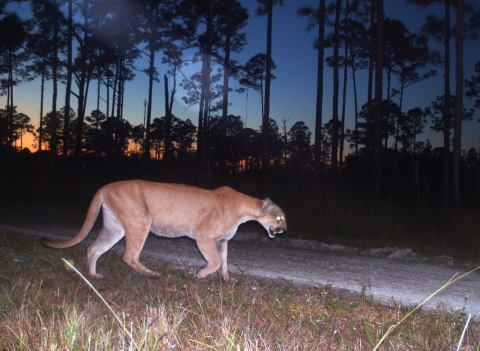About Us
Established in 1989, Southwest Florida’s Florida Panther National Wildlife is located within the heart of the Big Cypress Basin, encompassing the northern reach of the Fakahatchee Strand, the largest cypress strand in the Big Cypress swamp. This Refuge protects core habitat for the endangered Florida panther and all native wildlife who roam within the apex predator’s habitats.
Our Mission
Each unit of the National Wildlife Refuge System is established to serve a statutory purpose that targets the conservation of native species dependent on its lands and waters. All activities on those acres are reviewed for compatibility with this statutory purpose.
Refuge-Specific Goals at Florida Panther National Wildlife Refuge:
- Provide optimum habitat conditions for the Florida panther.
- Restore and conserve the natural diversity, abundance, and ecological function of refuge flora and fauna.
- Conduct research, monitoring and evaluations to improve management of flora and fauna on the refuge and within the south Florida ecosystem.
- Develop appropriate and compatible wildlife-dependent recreation and environmental education programs.
- Promote interagency and private landowner cooperation for the protection and management of natural and cultural resources within southwest Florida.
Our History
Immediately prior to refuge establishment, the land was owned by the Collier family and was primarily used for private hunting leases and cattle grazing. A few home sites and hunting camps were located on the land. In 1989, the US Fish & Wildlife Service purchased the initial 24,300 acres from the Collier family for $10.3 million dollars to become the Florida Panther National Wildlife Refuge, under the authority of the Endangered Species Act, to protect the Florida panther and its habitat. The refuge is located in the core of occupied panther territory, and protection of this important area was needed to ensure that not only panthers and their habitat were protected, but also important wildlife corridors that connected adjacent private and public lands. In 1996, the refuge was expanded to 26,400 acres with the addition of more Collier family land through the Arizona-Florida Land Exchange Act of 1988.
For hundreds of years, towering cypress trees up to 130 feet tall and 25 feet in circumference dominated the landscape of what is now Florida Panther NWR. In response to World War II, logging of cypress trees throughout the Big Cypress basin started in 1944. An average of 1,000,000 board feet per week were harvested from the swamp using temporary railroads. The logging operations started in what is now Fakahatchee Strand State Preserve and moved north through the refuge area. By 1957, the last of the trees were harvested, except for those found in the Corkscrew Audubon Preserve. Slowly the cypress swamps have recovered as a new generation of cypress replaces the fallen giants. Many of the logging scars have healed over the past five decades. The old raised railroad beds are still utilized by refuge staff to access portions of the refuge.
Other Facilities in this Complex
Florida Panther National Wildlife Refuge is managed as part of the Southwest Florida Gulf Coast Refuge Complex.


